Commentary
Article
The Community Pharmacist’s Role in the Management of Migraine
Author(s):
Migraine is a chronic neurological disease characterized by throbbing or pulsating unilateral or bilateral headache that can last from hours to days.
Image credit: vectorfusionart | stock.adobe.com
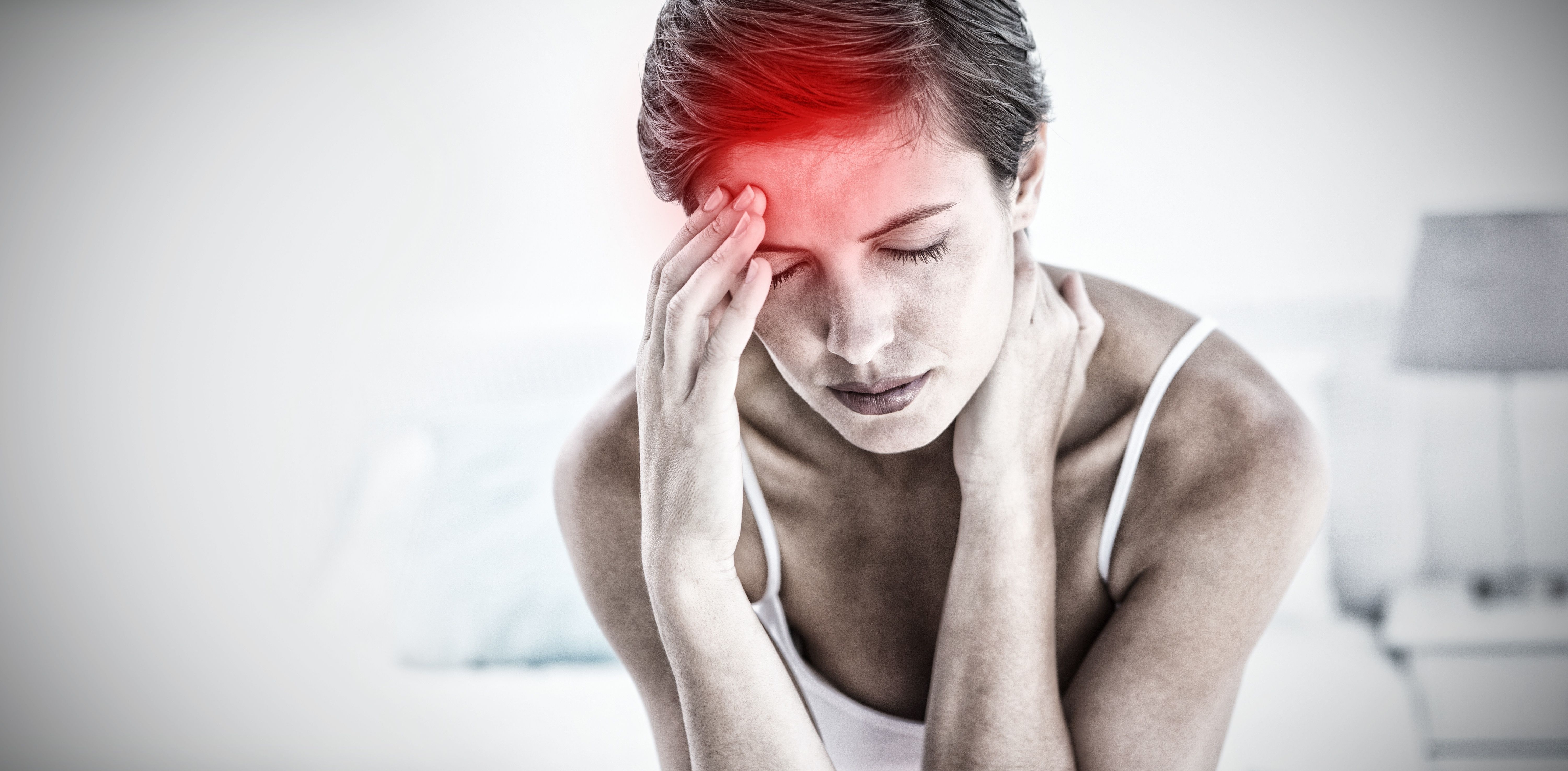
Introduction
Among the primary headache types, migraine remains one of the most severe and debilitating types, especially in women and those under the age of 50. Migraine is a chronic neurological disease characterized by throbbing or pulsating unilateral or bilateral headache that can last from hours to days. Migraine headaches can also be associated with additional symptoms including nausea and vomiting, photophobia, and phonophobia.1-4 Migraine headaches are a major financial burden with direct and indirect health care costs affecting patients, families, and employers.5-7
Pathophysiology
Migraine pathophysiology is complex, and although many theories have been suggested, most recent evidence involves the trigeminovascular system.8 Migraines can be triggered by many factors including stress, hormonal changes, foods, weather changes, odors, medications, and more (Table 19-13).9-13 When a migraine is triggered, the trigeminal nerve is activated and proinflammatory neuropeptides are released. Among these is calcitonin-gene related peptide (CGRP) and other neurotransmitters that cause vasodilation and inflammation, resulting in activation of pain sensing neurons and a hypersensitive pain environment.12-16
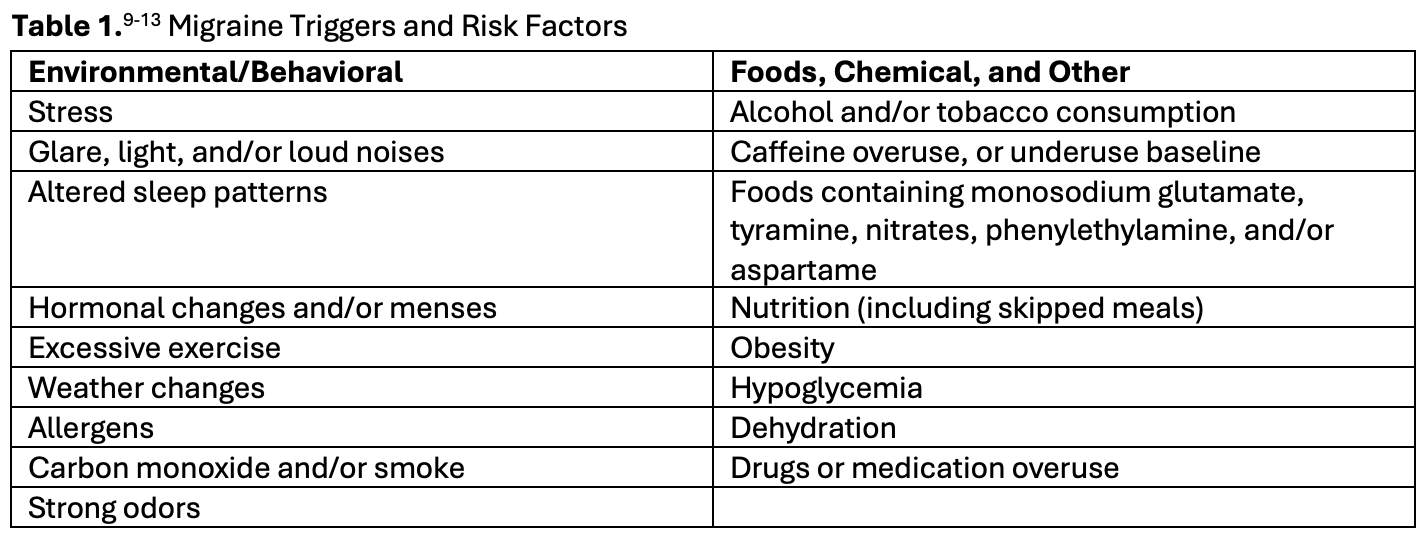
Clinical Presentation
The clinical presentation of migraine is heterogeneous, although it is described as having 4 major phases. Patients may not experience each phase, and in some cases may present atypically. The common phases described include the premonitory, aura, headache, and postdrome phases and are described in figure 1.1,13 The premonitory phase usually occurs 1 to 2 days prior to the aura and headache phase, with features that include fatigue, irritability, and food cravings. This phase is followed by the aura phase in some patients, which may include visual disturbances, sensitivity to light, and other features. The subsequent headache follows and is typically a pulsatile unilateral pain, often accompanied by nausea, vomiting, photophobia, and phonophobia. The final phase, called the postdrome phase, is the period post-headache and includes lethargy and fatigue.1,17-19
Figure 1.13,17-19
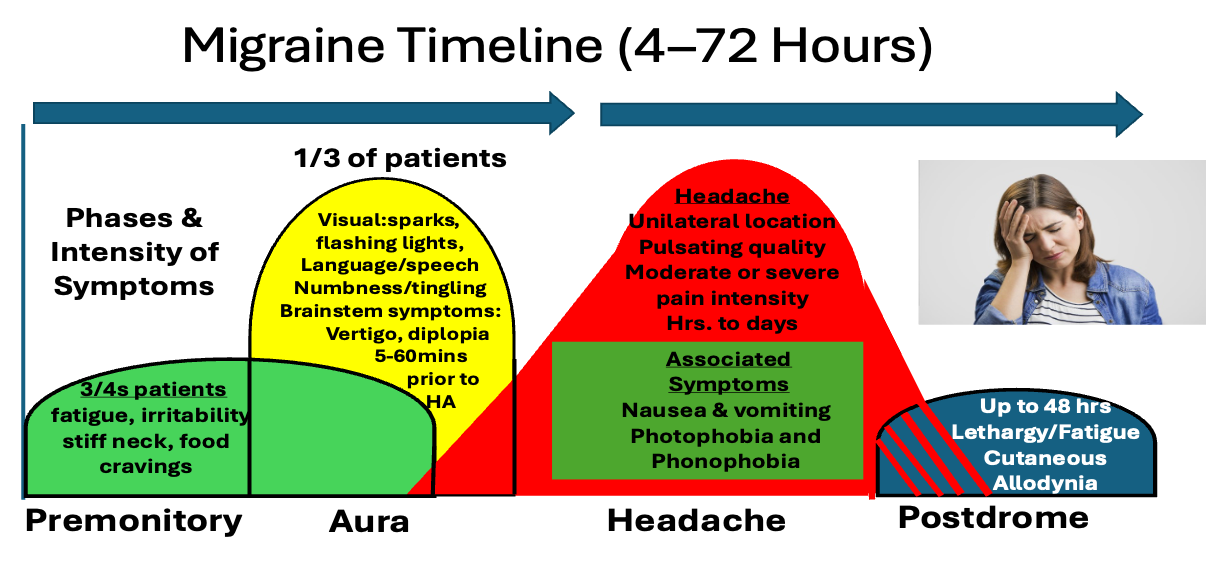
Other primary headache discussions are beyond the scope of this article, but include cluster headache and its variants, tension headaches, and numerous other types classified by the Headache Classification Committee of the International Headache Society (IHS).1 The most recent headache classification system published by the International Headache classification Society (IHCS) defines the major categories of migraine as those with and without aura and, in addition, defines migraine as chronic if it presents ≥15 days per month and episodic if ≤15 days per month.1,20,21
The diagnosis of migraine requires a referral to a primary care practitioner or neurologist, especially if patients present with mimicking conditions and/or “red flag” or “alarm” symptoms (Table 222-25). The “red flags” listed in Table 2 can be helpful during these initial encounters, offering guidance to the pharmacist during the screening for potential serious events requiring a referral to a medical practitioner or emergency care.22-25
Table 2.22-25
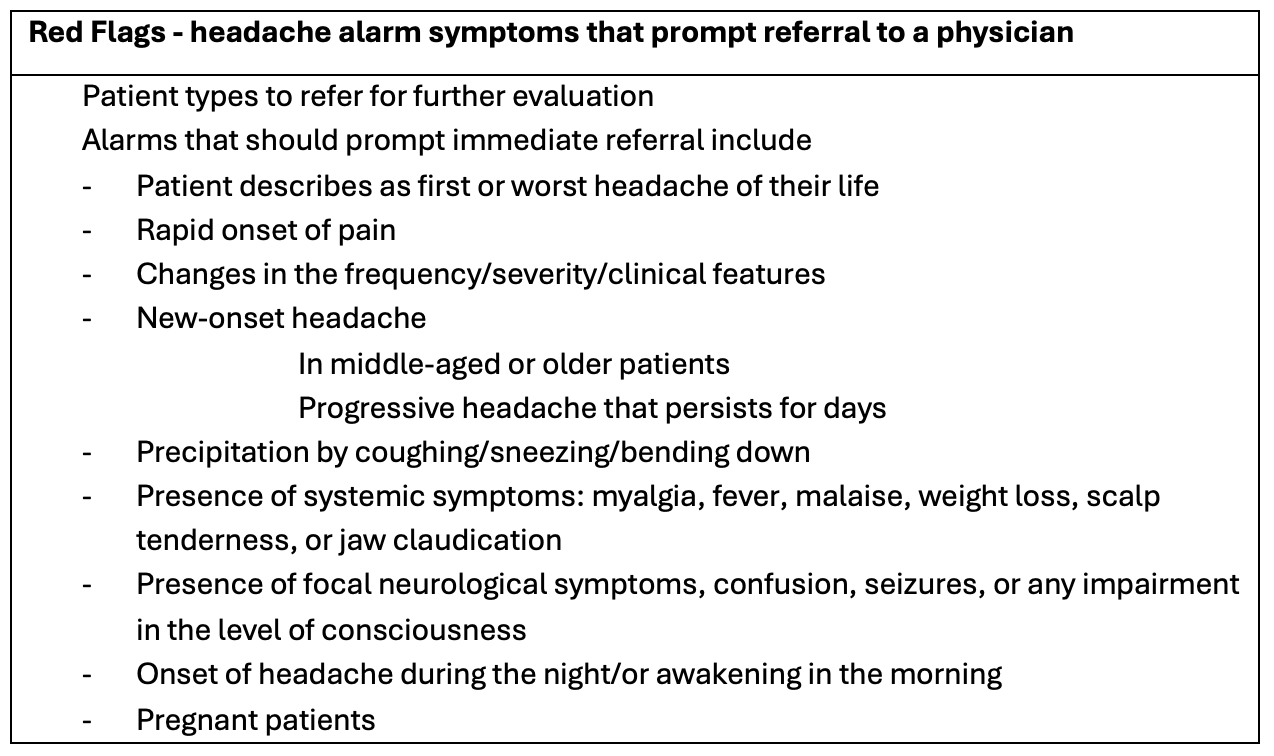
The community pharmacist on the front lines of health care is easily accessible to patients with migraines. Pharmacists can play an important triage role when approached by patients with headaches in their pharmacies or noticing patients in the OTC analgesic section that appear to be looking for medications. All pharmacy staff may assist with this observation by notifying the pharmacist on duty regarding patients that appear to be or who ask about analgesics.26-29 To assist the pharmacist in this process, numerous screening tools are available which have a high sensitivity for diagnosing migraine (Table 330-36). These tools vary from short interview questions, such as in the ID Migraine Screener, to more extensive evaluations of how migraine may be affecting a patient’s quality of life, such as the Migraine Disability Assessment Scale (MIDAS). These screening tools and questionnaires can not only gauge migraine severity but also provide information to share with other members of the patients’ health care team, offering an intradisciplinary approach to care. In addition, the pharmacist can monitor the patient during their follow-up visits to the pharmacy.30-36
Table 3.30-36 Headache Screening Tools
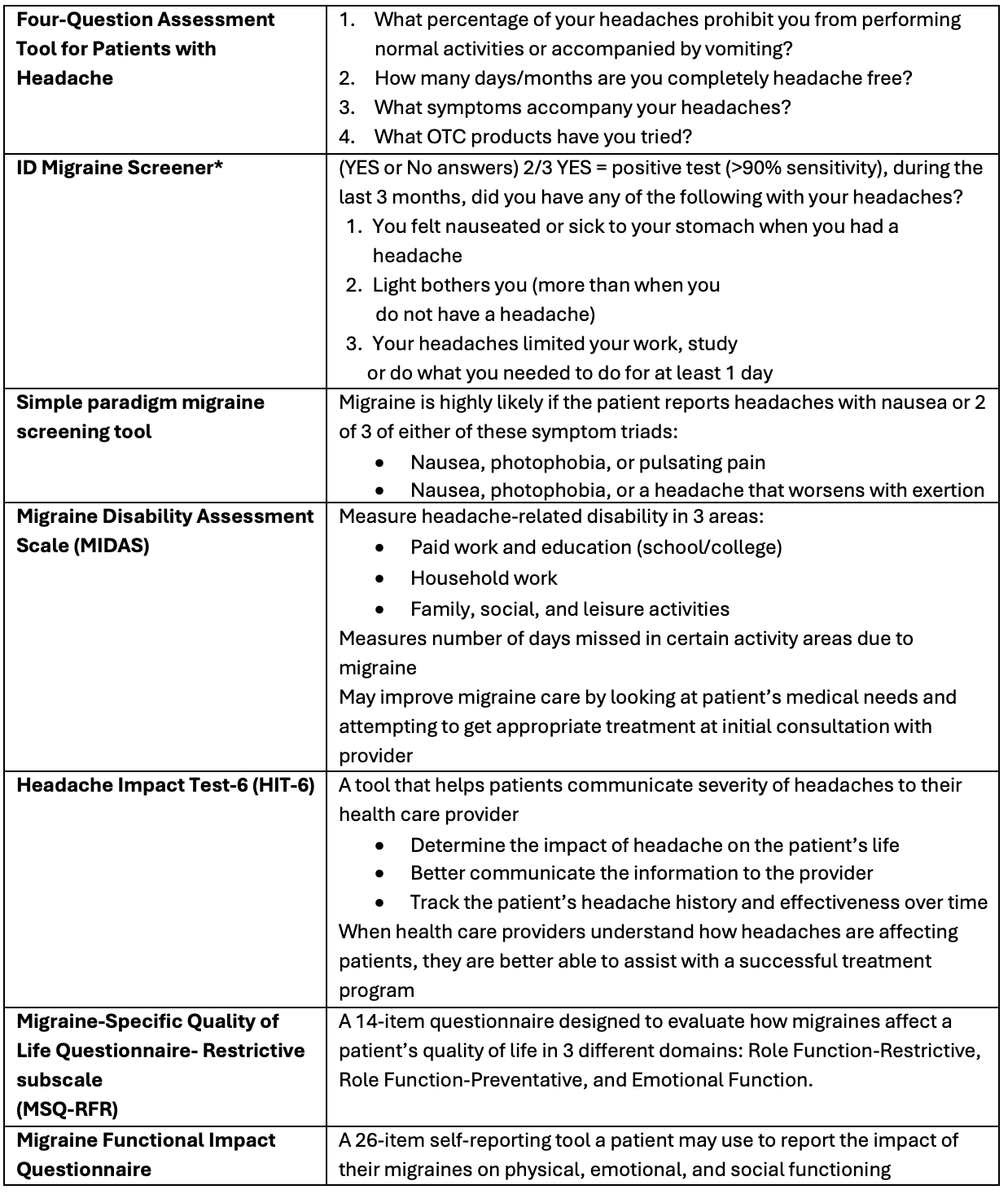
After an initial interaction with a patient who has headaches, including reviewing their history and/or conducting a screening test, the community pharmacist can make some recommendations for care.37-39 Patients who describe mild to moderate migraine symptoms may benefit from numerous non-pharmacological interventions and recommendations (Table 436-63,65-72) including lifestyle changes and improving sleep, diet, and stress levels. Other interventions may include recommending dark quiet environments, cold packs, and numerous neuromodulation (NM) devices, which are reviewed in Table 5.47-63 These NM devices work in a variety of ways to interfere with nerves involved with pain transmission processes, which propagate migraine pain and other symptoms.47-63
Table 4.36-63,65-72
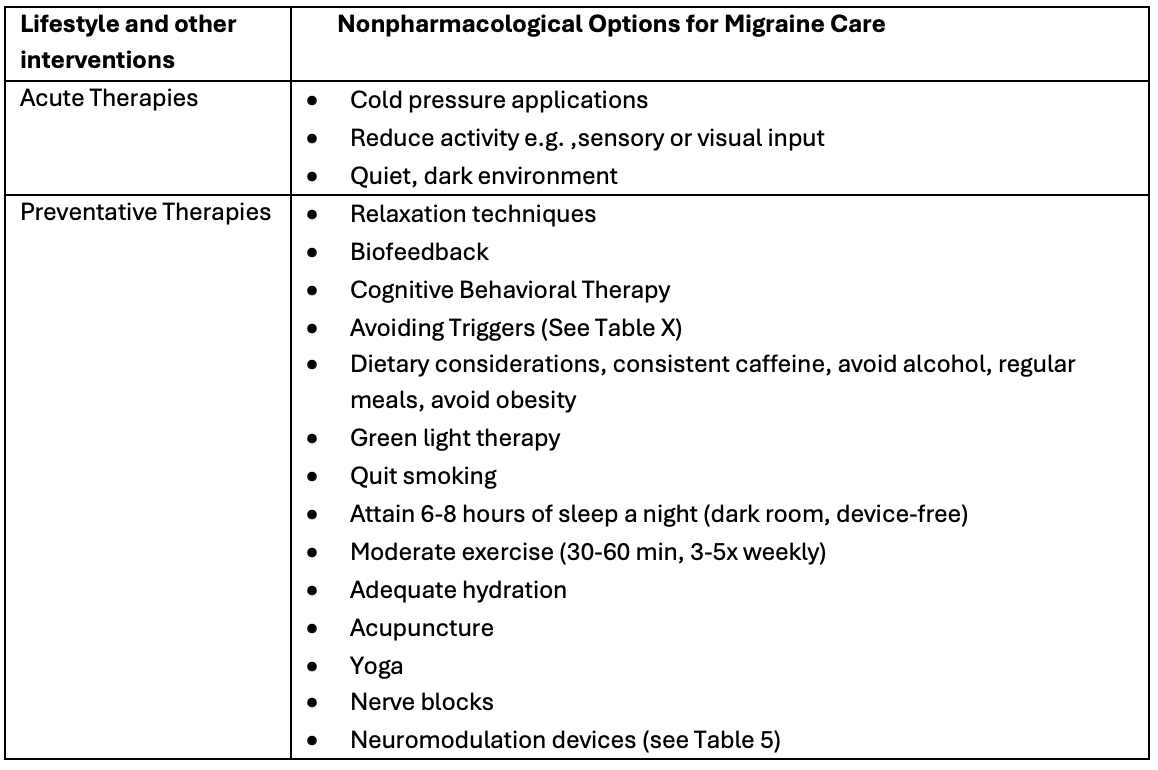
Table 5.47-63
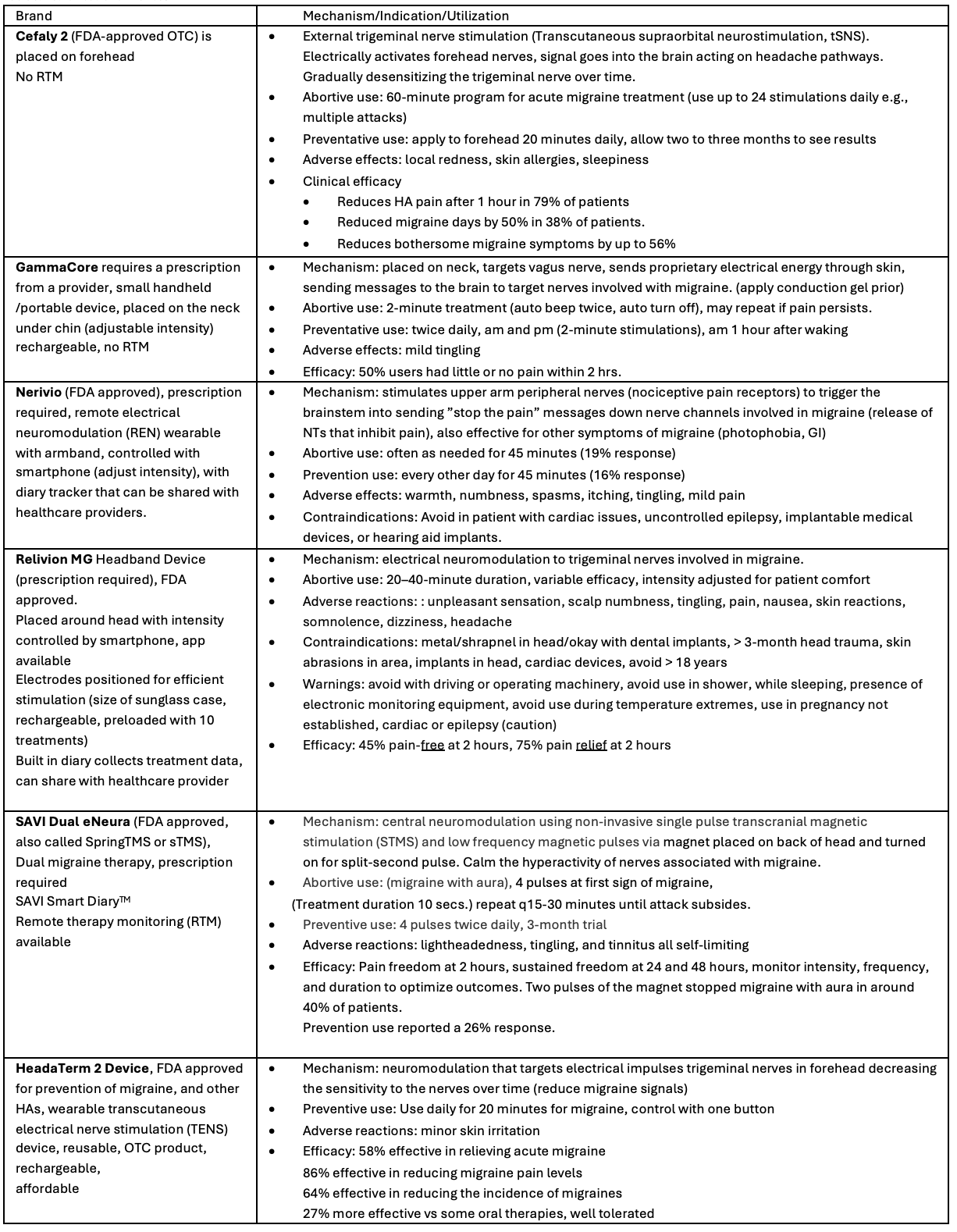
Patients with migraine should also be encouraged to keep a detailed diary that tracts migraine attacks, triggers, symptoms, severity, timing, length of attack, frequency, and response to treatments. Numerous mobile apps are available to utilize for a diary, including Migraine Buddy, Curelator NI-Headache, iHeadache, Migraine Diary, and others.64
Although there are not universal diets designed for migraine, certain diets may be beneficial. The brain is always working and needs protection from stress, particularly cellular and oxidative stress. Foods that are brain healthy include salmon; tuna; nuts; berries; and green leafy vegetables like broccoli, kale, and cauliflower. Processed food is reported to cause inflammation, so avoiding it is in the best interest of these patients. The popular Mediterranean diet is a great option due to its abundance of anti-inflammatory foods, good carbohydrates and fats, and olive oil, all of which are brain healthy. Limiting sugar may also be helpful to avoid the rise in insulin, which triggers inflammation. Food triggers should be a component of the patient's migraine diary as mentioned above.65-72
Medication Therapy
Migraine therapy is evolving, and newer medications are available that may provide patients with improved response and tolerability. The majority of migraine pharmacotherapies require prescriptions and pharmacists can use their clinical knowledge about the role of these agents to have discussions with patients and make recommendations to their providers. The community pharmacist is in a prime position to work with migraine patients and their providers to optimize therapies, improve quality of life, and minimize health care costs. Their initial involvement should be questioning patients regarding their headaches, utilizing simple screening tools, and discussing present or previous therapies. Providers with busy practices may appreciate input on the management of migraine in their patients. Discussions may include newer options for treatment, third party coverage, patient assistance, monitoring, and follow-up plans. Migraine treatment involves acute therapies (see Table 621,24,28,29,71,74,75–78,83,85,86,90,94,95) and preventive therapies (see Table 71,72-75,83,84,92), and the role of each will depend on individual patient responses. Although not a cure, medications and their combinations can have a significant impact on migraine symptoms and quality of life. The general goal for abortive therapies is taking them as early as possible, such as during the premonitory phase, and achieving pain relief or freedom within 2 hours.71-92 Key points are avoiding medication overuse headache.79,80
Table 6.21,24,28,29,71,74,75–78,83,85,86,90,94,95
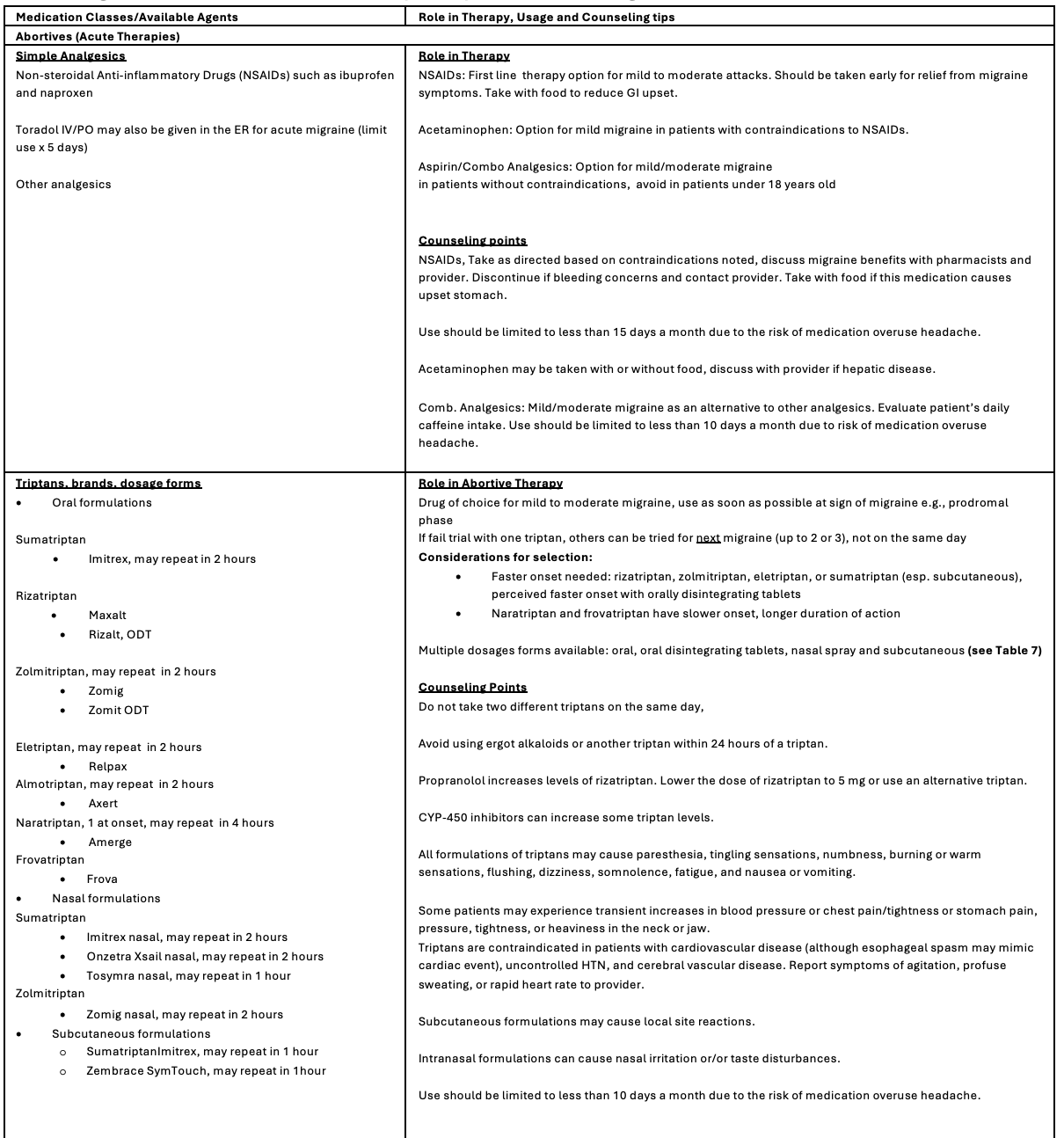
Table 6.21,24,28,29,71,74,75–78,83,85,86,90,94,95
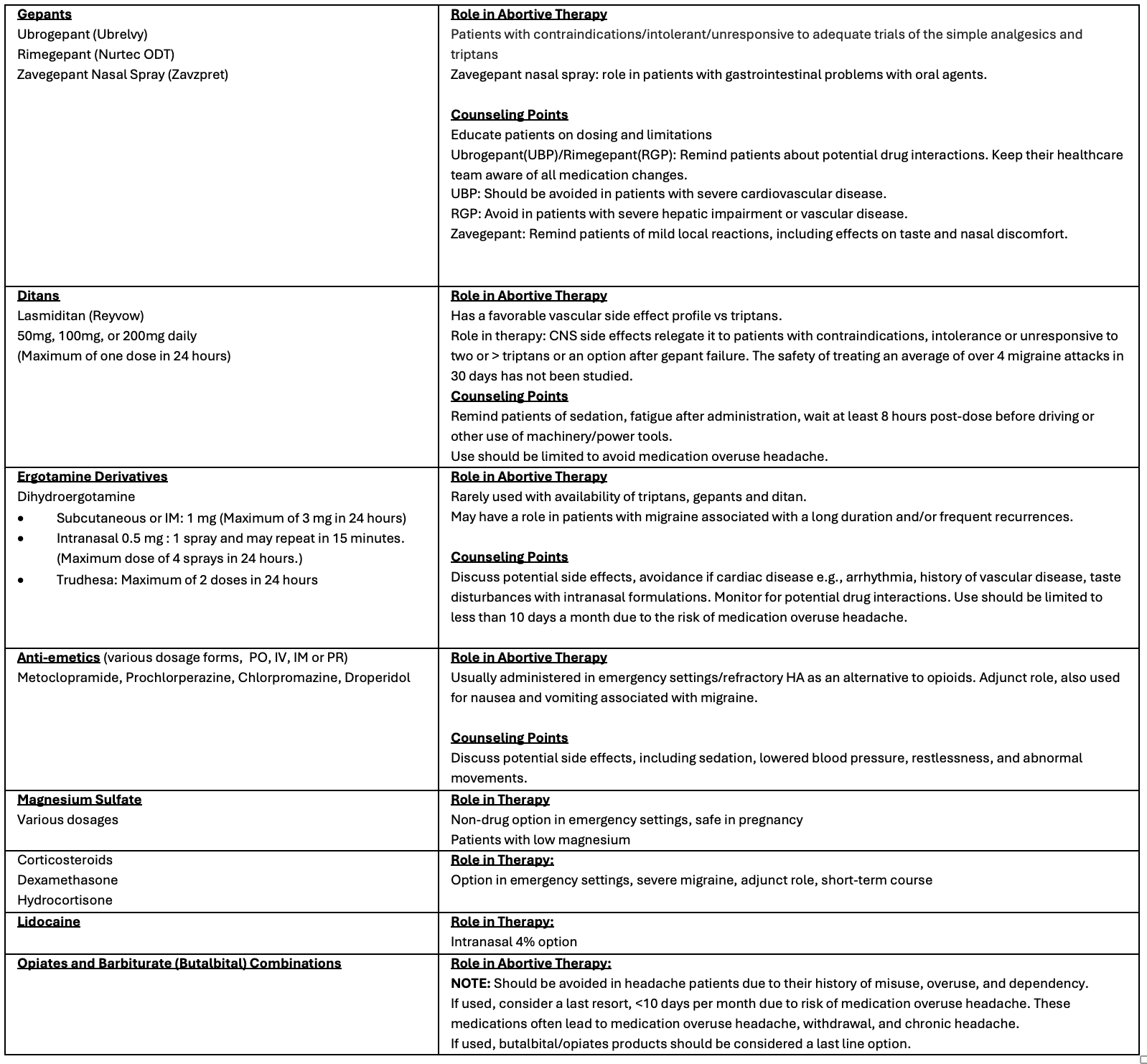
Table 7.1,72-75,83,84,92
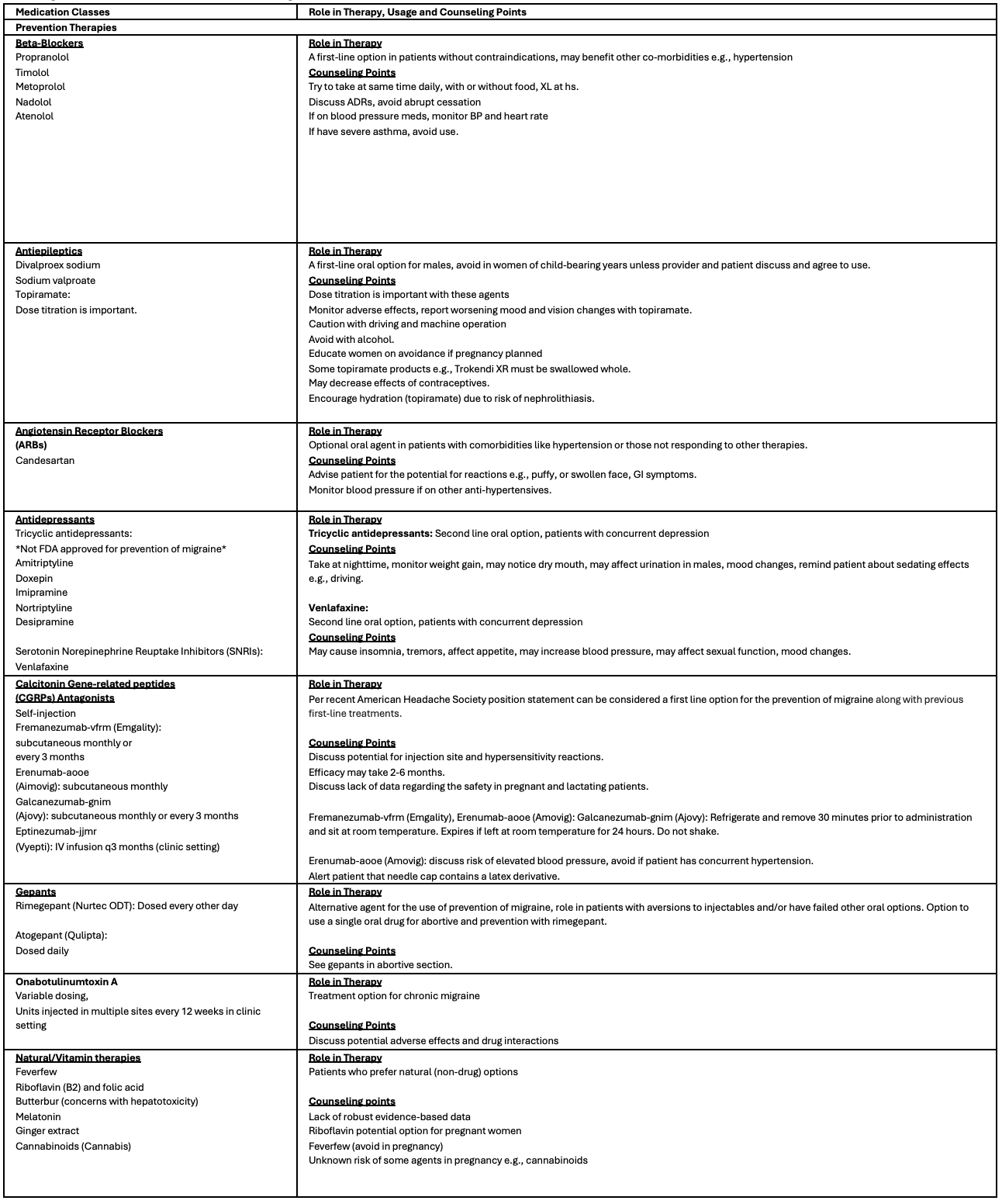
Acute management of mild to moderate migraine includes OTC agents such as simple analgesics and their combinations, along with non-steroidal anti-inflammatory drugs (NSAIDs). The pharmacist can offer guidance on dosing, restrictions on frequency of use, and follow-up on efficacy.81,82,91
Patients with moderate to severe migraines will usually require prescription therapies such as triptans (Table 871,75,76-79,83), gepants, others. Depending on migraine frequency, patients may require preventive management, as well, with options outlined in Table 8. Guidelines on when to prescribe preventives are published in detail by the American Headache Society, but in general it is based on migraine days per month and influence on quality of life.57,71,72 The migraine patient is best managed with a multimodal approach, using various lifestyle and non-pharmacological interventions, along with the layering or combinations of various pharmacotherapies. Comorbidities associated with migraine may allow overlap of treatment options, although this may also be associated with drug interactions, providing an additional monitoring opportunity for pharmacists.71-80 The routine use of opiates or barbiturate-containing compounds should be avoided because they are less effective than conventional treatments and associated with addiction and medication overuse headache.71,72,83-86
Table 8. Available triptans, formulations, usual doses/pharmacokinetics, and other properties71,75,76-79,83
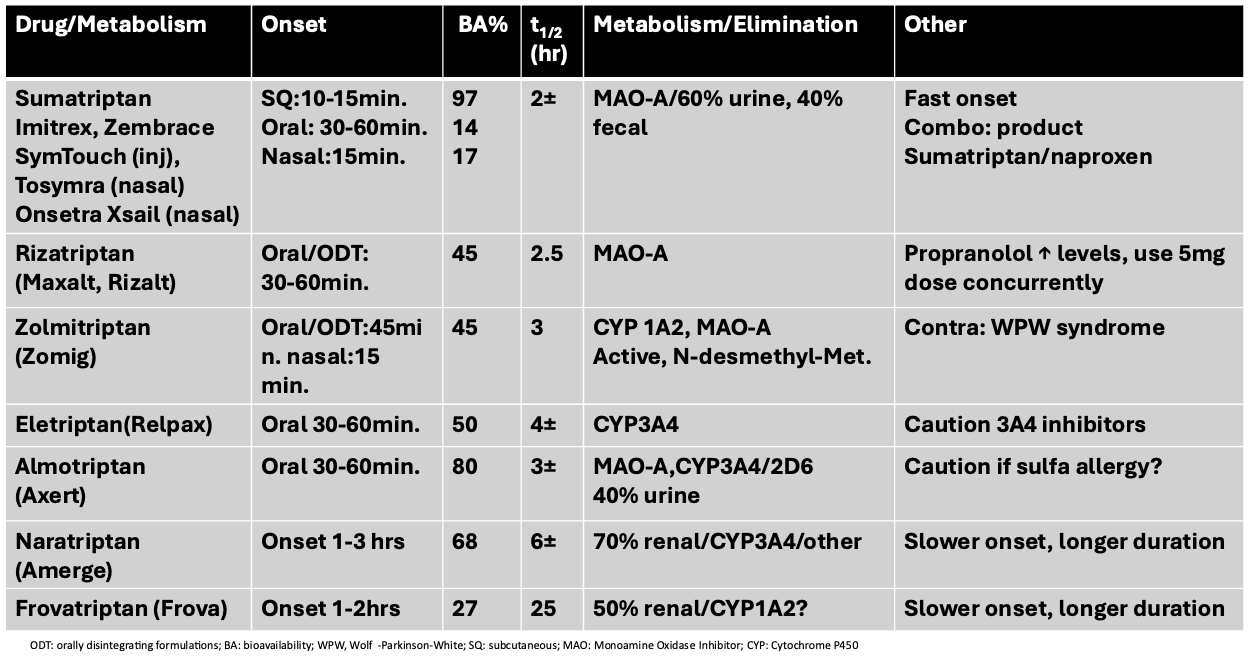
Because a majority of patients with migraines are women of childbearing years, pharmacists should be aware of how to initiate migraine abortive recommendations in these patients. Fortunately, the rise of estradiol in pregnancy results in many pregnant migraine patients experiencing less frequent and reduced severity of attacks. If treatment is required, a discussion with provider, patient, and pharmacist is warranted with shared decision-making. Recommendations include acetaminophen and/or a combination of acetaminophen with caffeine, with a limit of 200 mg daily of caffeine. The use of NSAIDs in severe attacks should be limited to the second trimester due to potential fetal effects. In the emergency department settings, intravenous metoclopramide alone or in combination with diphenhydramine may be useful for headache pain and associated nausea. Secondary options include corticosteroids (e.g., prednisolone), intravenous sumatriptan, or magnesium.
There are limited data to recommend lasmiditan or gepants for the abortive therapy of migraine in pregnancy. Similar to abortive treatment, there is limited evidence for the use of preventive migraine medication during pregnancy and a discussion with the patient and provider should occur to consider preventive options. A general recommendation is for patients to discontinue their preventive migraine medications via taper during pregnancy. If treatment is necessary, some options may include calcium channel blockers (e.g., amlodipine, nifedipine, verapamil) or antihistamines (e.g., cyproheptadine, diphenhydramine). The risk-benefit ratio should be considered for using traditional oral therapies in pregnant migraine patients (e.g., beta-blockers). Avoidence of antiseizure medications (e.g., topiramate and valproic acid), antidepressants (e.g., venlafaxine and amitriptyline), and the CGRP monoclonal antibodies and antagonists is recommended.72-75,87,88
Over the last 5 to 6 years, newly approved therapies have offered patients more options for both abortive and preventive care of their migraines. These agents provide an excellent opportunity for pharmacists to further engage patient care by educating patients on their role in therapy. These agents involve new delivery options, requiring patient education on proper use of self-injectables, new nasal and oral dosage delivery systems, along with assistance on third party payment challenges.1,58,83,84,90-94
Medication Overuse Headache
When certain medications are used more than the recommended frequency, a tolerance may develop to the medications and the severity and frequency of their headaches may increase. Certain drugs that may be problematic if overused include combination pain relievers containing barbiturates or opioids, triptans, ergotamines, combination analgesics containing caffeine, aspirin, acetaminophen, and NSAIDs. Patients that consume more than 200 mg of caffeine daily are also at an increased risk of medication overuse headache. Community pharmacists are in a prime position to monitor a patient’s use of analgesics.79,80,85
Conclusion
Migraine headaches remain a debilitating condition, management has improved with evolving therapies. Pharmacists’ role in the community setting provides the ideal position to help migraine patients. A community pharmacist can identify the migraine headache and recommend OTC medication while educating patients on medication overuse headache that could worsen their condition. Not only can a pharmacist educate a patient on administration and adverse effects of a medication, but they may also use screening tools and questionnaires to assess a patient’s migraine severity and quality of life. Additionally, pharmacists should be aware of alarm symptoms associated with headaches that may require more immediate attention. A pharmacist’s role in the health care team is invaluable as they are easily accessible and available to follow up with a patient. Patients can trust their pharmacist to educate them and suggest non-pharmacological therapies, as well as to ease concerns or fears they may have about starting new therapies. Pharmacists are knowledgeable, well-equipped, and available to the patient suffering from migraines and remain a first-line source when a patient is looking for therapy, referrals, and education regarding their migraine treatment.39,81,82,95
References
1. Headache Classification Committee of the International Headache Society (IHS) the International Classification of headache disorders, 3rd edition. Cephalalgia. 2018;38(1):1-211.
2. Lipton RB, Silberstein S. Episodic and chronic migraine headache: breaking down barriers to optimal treatment and prevention. Headache. 2015;55(suppl 2):103-112.
3. Migraine Research Foundation. Migraine facts. https://migraineresearchfoundation.org/aboutmigraine/migraine-facts/. Accessed August 12, 2021.
4. Vetvik KG, MacGregor EA. Sex differences in the epidemiology, clinical features, and pathophysiology of migraine. Lancet Neurol. 2017;16:76-87.
5. Burch RC, Loder S, Loder E, Smitherman TA. The prevalence and burden of migraine and severe headache in the United States: updated statistics from government health surveillance studies. Headache. 2015;55:21-34.
6. Hareendran A, Mannix S, Skalicky A, et al. Development and exploration of the content validity of a patient-reported outcome measure to evaluate the impact of migraine—the migraine physical function impact diary (MPFID). Health Qual Life Outcomes. 2017;15(1):224.
7. Buse DC, Scher AI, Dodick DW, et al. Impact of migraine on the family: perspectives of people with migraine and their spouse/domestic partner in the CaMEO study. Mayo Clin Proc. 2016;25;S0025-6196(16)00126-9.
8. Noseda R, Burstein R. Migraine pathophysiology: anatomy of the trigeminovascular pathway and associated neurological symptoms, cortical spreading depression, sensitization and modulation of pain. Pain. 2013;154(suppl 1):S44-S53.
9. Zaeem Z, Zhou L, Dilli E. Headaches: a Review of the Role of Dietary Factors. Curr Neurol Neurosci Rep. 2016 Nov;16(11):101. doi: 10.1007/s11910-016-0702-1. PMID: 27714637.
10. Lipton RB, Buse DC, Nahas SJ, Tietjen GE, Martin VT, Löf E, Brevig T, Cady R, Diener HC. Risk factors for migraine disease progression: a narrative review for a patient-centered approach. J Neurol. 2023 Dec;270(12):5692-5710. doi: 10.1007/s00415-023-11880-2. Epub 2023 Aug 24. PMID: 37615752; PMCID: PMC10632231.
11. Levy D, Strassman AM, Burstein R. A critical view on the role of migraine triggers in the genesis of migraine pain. Headache. 2009 Jun;49(6):953-7. doi: 10.1111/j.1526-4610.2009.01444.x. PMID: 19545256.
12. Silberstein SD. Drug-induced headache. Neurol Clin. 1998 Feb;16(1):107-23. doi: 10.1016/s0733-8619(05)70369-8. PMID: 9421543.
13. Dodick DW. Migraine. Lancet. 2018;391(10127):1315-1330.
14. Charles A. The pathophysiology of migraine: implications for clinical management. Lancet Neurol. 2018;17(2):174-182.
15. Russo AF. Calcitonin gene-related peptide (CGRP): a new target for migraine. Annu Rev Pharmacol Toxicol. 2015;55:533-552.
16. Hansen JM, Hauge AW, Olesen J, Ashina M. Calcitonin gene-related peptide triggers migraine-like attacks in patients with migraine with aura. Cephalalgia. 2010;30(10):1179-1186.
17. Laurell K, Artto V, Bendtsen L, et al. Premonitory symptoms in migraine: a cross-sectional study in 2714 persons. Cephalalgia. 2016;36:951-959.
18. Lipton RB, Bigal ME, Ashina S, et al. Cutaneous allodynia in the migraine population. Ann Neurol. 2008;63:148-158
19. Hansen JM, Charles A. Differences in treatment response between migraine with aura and migraine without aura: lessons from clinical practice and RCTs. J Headache Pain. 2019;20(1):96.
20. Katsarava Z, Buse DC, Manack AN, Lipton RB. Defining the differences between episodic migraine and chronic migraine. Curr Pain Headache Rep. 2012;16(1):86-92.
21. Bigal ME, Serrano D, Buse D, et al. Acute migraine medications and evolution from episodic to chronic migraine: a longitudinal population-based study. Headache. 2008;48:1157-1168.
22. Kouremenos E, Arvaniti C, Constantinidis TS; Hellenic Headache Society. Consensus of the Hellenic Headache Society on the diagnosis and treatment of migraine. J Headache Pain. 2019;20(1):113.
23. Lipton RB, Bigal ME, Amatniek JC, Stewart WF. Tools for diagnosing migraine and measuring its severity. Headache. 2004;44:387-398.
24. Tabatabai RR, Swadron SP. Headache in the emergency department: avoiding misdiagnosis of dangerous secondary causes. Emerg Med Clin North Am. 2016;34(4):695-716.
25. Zodda D, Procopio G, Gupta A. Evaluation, and management of life-threatening headaches in the emergency department. Emerg Med Pract. 2019;21(2):1-20.
26. Blumenfeld A, Tischio M. Center of excellence for headache care: group model at Kaiser IPermanente. Headache. 2003;43(5):431-440.
27. Baratta F, Allais G, Rolando S et al., Prevention, education and counselling: the worldwide role of the community pharmacist as an epidemiological sentinel of headaches. Neurol Sci. 2019 May;40(Suppl 1):15-21.
28. Malik SN, Hopkins M, Young WB, Sliberstein SD. Acute migraine treatment: patterns of use and satisfaction in a clinical population. Headache. 2006;46:773-780.
29. Lipton RB, Stewart WF. Acute migraine therapy: do doctors understand what migraine patients want from therapy? Headache. 1999;39(suppl 2):S20-S26.
30. Lipton RB, Dodick D, Sadovsky R, et al; ID Migraine validation study. A self-administered screener for migraine in primary care: the ID Migraine validation study. Neurology. 2003;61(3):375-382.
31. The Migraine Disability Assessment test. https://headaches.org/wpcontent/uploads/2018/02/MIDAS.pdf. Accessed July 19, 2020.
32. Rapoport AM, Bigal ME. ID-migraine. Neurol Sci. 2004 Oct;25 Suppl 3:S258-60. doi: 10.1007/s10072-004-0301-9. PMID: 15549552.
33. https://health.mil/Reference-Center/Publications/2020/07/31/Headache-Impact-Test-HIT6
34. Shibata M, Nakamura T, Ozeki A, Ueda K, Nichols RM. Migraine-Specific Quality-of-Life Questionnaire (MSQ) Version 2.1 Score Improvement in Japanese Patients with Episodic Migraine by Galcanezumab Treatment: Japan Phase 2 Study. J Pain Res. 2020 Dec 31;13:3531-3538. doi: 10.2147/JPR.S287781. PMID: 33408512; PMCID: PMC7781358.
35. Stokes J, Dodick D, Lipton R. Psychometric Evaluation of the Migraine-Specific Quality of Life Questionnaire (MSQ v2.1) Using Data From Phase 3 Clinical Trials in Patients With Chronic Migraine (CM) and Episodic Migraine (EM). Neurology 2023;100(17,suppl 2)
36. https://www.evidera.com/migraine-functional-impact-questionnaire-mfiq/
37. Mauskop A. Nonmedication, alternative, and complementary treatments for migraine. Continuum (Minneap Minn). 2012;18(4):796-806.
38. Puledda F, Shields K. Non-pharmacological approaches for migraine. Neurotherapeutics. 2018;15(2):336-345.
39. Diamond ML, Wenzel RG, Nissan GR. Optimizing migraine therapy: evidence-based and patient-centered care. Expert Rev Neurother. 2006;6(6):911-919.
40. Halker Singh RB, Ailani J, Robbins MS. Neuromodulation for the Acute and Preventive Therapy of Migraine and Cluster Headache. Headache. 2019 Jul;59 Suppl 2:33-49. doi: 10.1111/head.13586. PMID: 31291017.
41. Fernandes L,Multiple cranial nerve blocks as an alternative preventative therapy for chronic migraine [published online March 30, 2020]. Headache. doi: 10.1111/head.13792March 25, 2020
42. Pistoia F, Sacco S, Carolei A. Behavioral therapy for chronic migraine. Curr Pain Headache Rep. 2013;17(1):304.
43. Long C, Ye J, Chen M, et al. Effectiveness of yoga therapy for migraine treatment: a meta-analysis of randomized controlled studies. Am J Emergency Medicine. Published online May 2, 2022. doi: 10.1016/j.ajem.2022.04.050
44. Linde K, Allais G, Brinkhaus B, et al. Acupuncture for the prevention of episodic migraine. Cochrane Database Syst Rev. 2016;2016(6):CD001218.
45. Noton D. Migraine and photic stimulation: report on a survey of migraineurs using flickering light therapy. Complement Ther Nurs Midwifery. 2000;6:138-142.
46. Koseoglu E, Yetkin MF, Ugur F, Bilgen M. The role of exercise in migraine treatment. J Sports Med Phys Fitness. 2015;55(9):1029-1036.
47. https://www.emeterm.com/products/headaterm-2-migraine-headache-relief-device
48. Nihat M. Hokenek, Mehmet O. et al. Treatment of migraine attacks by transcutaneous electrical nerve stimulation in emergency department: A randomize controlled trial,The American Journal of Emergency Medicine 2021;39:80-85. (HeadaTerm2)
49. https://www.cefaly.com/
50. Theranica website. https://theranica.com/technology/#clinical-data
51. Hong P, Liu Y, Wan Y et al.Transcranial direct current stimulation for migraine: a systematic review and meta-analysis of randomized controlled trials. CNS Neurosci Ther. 2022;28(7):992-998.
52. Garcia-Ortega R, Edwards T, Moir L, Aziz TZ, Green AL, FitzGerald JJ. Burst Occipital Nerve Stimulation for Chronic Migraine and Chronic Cluster Headache. Neuromodulation. 2019;22(5):638-644.
53. Lloyd JO, Hill B, Murphy M, Al-Kaisy A, Andreou AP, Lambru G. Single-Pulse Transcranial Magnetic Stimulation for the preventive treatment of difficult-to-treat migraine: a 12-month prospective analysis. J Headache Pain. 2022;23(1):63.
54. Tepper SJ. Treating migraine with neuromodulation devices. https://americanmigrainefoundation.org/resource-library/spotlight-neuromodulation-devicesheadache. Accessed July 7, 2024.
55. Chou DE, Gross GJ, Casadei CH, Yugrakh MS. External trigeminal nerve stimulation for the acute treatment of migraine: open-label trial on safety and efficacy. Neuromodulation. 2017;20(7):678-683.
56. Tepper SJ et al. Migraine treatment with external concurrent occipital and trigeminal neurostimulation-A randomized controlled trial. Headache. 2022;62(8):989-1001.
57. Ailani J, Burch RC, Robbins MS; Board of Directors of the American Headache Society. The American Headache Society Consensus Statement: Update on integrating new migraine treatments into clinical practice. Headache. 2021 Jul;61(7):1021-1039. doi: 10.1111/head.14153. Epub 2021 Jun 23. PMID: 34160823.
58. Barker AT, Shields K. Transcranial Magnetic Stimulation: Basic Principles and Clinical Applications in Migraine. Headache. 2017 Mar;57(3):517-524. doi: 10.1111/head.13002. Epub 2016 Dec 28. PMID: 28028801.
59. Kuruvilla DE, Mann JI, Tepper SJ et al. Phase 3 randomized, double-blind, sham-controlled Trial of e-TNS for the Acute treatment of Migraine (TEAM). Sci Rep. 2022;12(1):5110.
60. Tassorelli C, Grazzi L, de Tommaso M et al. PRESTO Study Group. Noninvasive vagus nerve stimulation as acute therapy for migraine: The randomized PRESTO study. Neurology. 2018 ;91(4):e364-e373. doi: 10.1212/WNL.0000000000005857.
61. Yarnitsky D, Dodick DW, Grosberg BM et al. Remote Electrical Neuromodulation (REN) Relieves Acute Migraine: A Randomized, Double-Blind, Placebo-Controlled, Multicenter Trial. Headache. 2019;59(8):1240-1252.
62. Diener HC, Goadsby PJ, Ashina M, et al. Non-invasive vagus nerve stimulation (nVNS) for the preventive treatment of episodic migraine:The multicentre, double-blind, randomised, sham-controlled PREMIUM trial. Cephalalgia. 2019;39(12):1475-1487.
63. Tepper SJ, Rabany L, Cowan RP et al. Remote electrical neuromodulation for migraine prevention: A double-blind, randomized, placebo-controlled clinical trial. Headache. 2023; 63:377–389.
64. Hundert AS, Huguet A, McGrath PJ et al. Commercially available mobile phone headache diary apps: a systematic review. JMIR Mhealth Uhealth. 2014 Aug 19;2(3):e36. doi: 10.2196/mhealth.3452. PMID: 25138438; PMCID: PMC4147710.
65. Levy D, Strassman AM, Burstein R. A critical view on the role of migraine triggers in the genesis of migraine pain. Headache. 2009;49(6):953-957.
66. Zaeem Z, Zhou L, Dilli E. Headaches: a review of the role of dietary factors. Curr Neurol Neurosci Rep. 2016;16(11):101.
67. Borkum JM. Migraine triggers and oxidative stress: a narrative review and synthesis. Headache. 2016;56(1):12-35.
68. National Headache Foundation. Resources. https://headaches.org/resources/#headache-tools. Accessed June 2024.
69. Hajjarzadeh S, Bakhshimoghaddam F, Behrouz M et al. The relation of adherence to the DASH diet with migraine attack frequency and pain intensity in Iranian women: a cross-sectional study. Nutr Neurosci. 2024 Apr;27(4):353-360.
70. Finkel AG, Yerry JA, Mann JD. Dietary considerations in migraine management: does a consistent diet improve migraine? Curr Pain Headache Rep. 2013;17(11):373.
71. Diener HC, Tassorelli C, Dodick DW et al. International Headache Society Clinical Trials Standing Committee. Guidelines of the International Headache Society for controlled trials of acute treatment of migraine attacks in adults: Fourth edition. Cephalalgia. 2019;39(6):687-710.
72. Diener HC, Tassorelli C, Dodick DW et al. International Headache Society Clinical Trials Committee. Guidelines of the International Headache Society for controlled trials of preventive treatment of migraine attacks in episodic migraine in adults. Cephalalgia. 2020 ;40(10):1026-1044.
73. Loder E, Rizzoli P. Pharmacologic prevention of migraine: a narrative review of the state of the art in 2018. Headache. 2018;58(suppl 3):218-229.
74. Evers S, Afra J, Frese A et al. European Federation of Neurological Societies. EFNS guideline on the drug treatment of migraine--revised report of an EFNS task force. Eur J Neurol. 2009;16(9):968-81.
75. Reddy DS. The pathophysiological and pharmacological basis of current drug treatment of migraine headache. Expert Rev Clin Pharmacol. 2013;6(3):271-88.
76. Evans RW, Tepper SJ, Shapiro RE et al. The FDA alert on serotonin syndrome with use of triptans combined with selective serotonin reuptake inhibitors or selective serotonin-norepinephrine reuptake inhibitors: American Headache Society position paper. Headache. 2010;50(6):1089-99.
77. Dodick DW. Triptan nonresponder studies: implications for clinical practice. Headache. 2005 Feb;45(2):156-62. doi: 10.1111/j.1526-4610.2005.05031.x. PMID: 15705122.
78. Facts about triptans: how triptans work. National Headache Foundation website. headaches.org/2007/11/19/facts-about-triptans/. Accessed September 10,2024.
79. Saper JR, Da Silva AN. Medication overuse headache: history, features, prevention, and management strategies. CNS Drugs. 2013;27(11):867-77.
80. Diener HC, Holle D, Solbach K, Gaul C. Medication-overuse headache: risk factors, pathophysiology, and management. Nat Rev Neurol. 2016;12(10):575-83. doi:
81. Diamond ML, Wenzel RG, Nissan GR. Optimizing migraine therapy: evidence-based and patient-centered care. Expert Rev Neurother. 2006;6(6):911-919.
82. Wenzel RG, Sarvis CA, Krause ML. Over-the-counter drugs for acute migraine attacks: literature review and recommendations. Pharmacotherapy. 2003;23(4):494-505.
83. American Headache Society. The American Headache Society Position Statement On Integrating New Migraine Treatments Into Clinical Practice. Headache. 2019;59(1):1-18.
84. Charles AC et al. American Headache Society. Calcitonin gene-related peptide-targeting therapies are a first-line option for the prevention of migraine: An American Headache Society position statement update. Headache. 2024;64(4):333-341.
85. Wilson MC, Jimenez-Sanders R. Medication overuse headache: key points. American Migraine Foundation website. americanmigrainefoundation.org/resource-library/medication-overuse-headache-2/. Accessed February 8, 2019;
86. Loder E, et al; American Headache Society Choosing Wisely Task Force. Headache. 2013;53(10):1651-1659.
87. Ovadia C. Prescribing for pregnancy: managing chronic headache and migraine. Drug Ther Bull. 2021;59(10):152-156.
88. van Casteren DS, van den Brink AM, Terwindt GM. Migraine and other headache disorders in pregnancy. Handb Clin Neurol.;172:187-199.
89. Burch R. Epidemiology and Treatment of Menstrual Migraine and Migraine During Pregnancy and Lactation: A Narrative Review. Headache. 2020;60(1):200-216.
90. Moreno-Ajona D, Chan C, Villar-Martínez MD, Goadsby PJ. Targeting CGRP and 5-HT1F receptors for the acute therapy of migraine: a literature review. Headache. 2019;59(suppl 2):3-19.
91. Marmura MJ, Silberstein SD, Schwedt TJ. The acute treatment of migraine in adults: the american headache society evidence assessment of migraine pharmacotherapies. Headache. 2015 Jan;55(1):3-20. doi: 10.1111/head.12499. PMID: 25600718.
92. Charles AC et al. American Headache Society. Calcitonin gene-related peptide-targeting therapies are a first-line option for the prevention of migraine: An American Headache Society position statement update. Headache. 2024;64(4):333-341.
93. Petersen CL et al. Risk of stroke and myocardial infarction among initiators of triptans. JAMA Neurol 2024 Feb 5; [e-pub]. (https://doi.org/10.1001/jamaneurol.2023.5549)
94. Tran PT, Lapeyre-Mestre M, Berangere B, et al. Triptan use in elderly over 65 years and the risk of hospitalization for serious vascular events. J Headache Pain. Published April 26, 2024. doi:10.1186/s10194-024-01770-x
95. DeMaagd GA. Migraine Headache: The Pharmacist and the Role of OTC Medications. Pharmacy Times 2007; 73(3):106-117.
Newsletter
Stay informed on drug updates, treatment guidelines, and pharmacy practice trends—subscribe to Pharmacy Times for weekly clinical insights.






